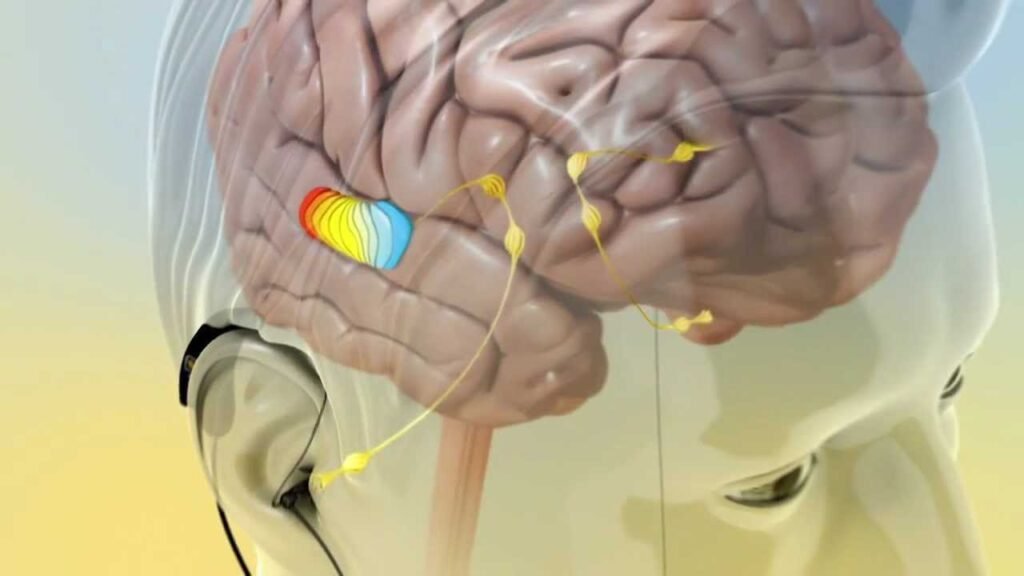Tinnitus Treatment – Causes and Treatment of Tinnitus
In the UK six million people experience sounds for which there is no external source. These people have tinnitus. The symptoms of tinnitus are often described as ringing, buzzing or whistling sounds that are perceived within the ears or the head. However, it is not the ear that is responsible. Instead, the causes for the tinnitus can be found in the brain.

The brain is made up from a huge number of active nerve areas which all have different roles. Sound information is processed via a very specific brain area known as the auditory cortex. The auditory cortex is divided up into areas that are responsible for processing different pitches in a similar way in which keys would be arranged on a piano.
Anything which causes us to lose our hearing can have the effect of disrupting this internal keyboard. This could be caused by medication, loud noises or just the natural ageing process. Due to this disruption, there is a reduction of activity in the keyboard areas affected by hearing loss and the nerves that make up the area can start to fire spontaneously. This is called neural synchronisation.
Read more: All-natural Remedies for Ringing In The Ears
Or to put it in another way, if the ear no longer talks to the auditory centre then the nerve cells in the auditory centre begin to chatter in an overactive and unregulated way. It is this abnormal overactivity which causes us to perceive the tinnitus signal. Over time this abnormal activity becomes permanent. Modern imaging procedures enable us to ‘see’ evidence of the abnormal neural synchrony within the auditory part of the brain.
This abnormal neural synchrony does not remain limited to the auditory centre. Brainwave measurements have shown that brain areas regulating attention, emotions and stress are also affected. The faulty signals in all these areas together allow the tinnitus tone to invade into our consciousness. This interaction of brain areas influences the individual level of distress and anxiety experienced by each person as well as the perceived volume and invasiveness of the tinnitus.
Is there a way to reduce and reverse the neural synchrony which is related to tinnitus? The neuroscientific answer to this question has been discovered by doctors and scientists of the Jülich Research Centre near Cologne Germany. It is called Acoustic Coordinated Reset CR® Neuromodulation. Treatment with Acoustic CR® Neuromodulation targets the exact cause of the problem.
This innovative treatment is designed to reduce hyperactivity in the specific regions of the brain that are responsible for generating the tinnitus sound. Acoustic CR Neuromodulation uses a complex mathematical algorithm to create a personalised sound prescription for each patient. The series of tones created are transmitted to the nerve cells in the brain of the patient in such a way that the cells abnormal synchrony is disrupted and hyperactivity is reduced.
In Acoustic CR Neuromodulation the synchronous nerve cell network is first stimulated actively from the outside by single tones that are spatially and temporally staggered. These force the nerve cells into subgroups, each with its own new rhythm. 4 tones are used to deliver this gentle targeted stimulation to the hearing (ringing in ears meaning) centre of the brain.
There are short pauses between the stimulation signals in order to remodel the nerve network. If repeated regularly and often enough, these stimulation signals will reduce the hyperactivity to such an extent that the abnormal neural synchrony will be permanently reversed. Acoustic CR Neuromodulation tones consist of individually measured and specifically calculated acoustic impulses which are transformed in the brain into corresponding electrical stimuli.
Read more: Tinnitus (Ringing in the Ears) Treatment and Diagnosis
The acoustic tones are generated by a small, matchbox size device — the ANM Neurostimulator — and administered to the tinnitus patient via medical headphones. Worn for about 4 to 6 hours a day, the device is comfortable and inconspicuous, allowing the treatment to be easily integrated into the patient’s daily routine. How can the stimulating Acoustic CR Neuromodulation signals be targeted to the correct brain area?
The signals are targeted by taking advantage of the keyboard-like structure of the auditory centre:
- The area of the auditory centre that is generating the tinnitus is found by determining the exact individual pitch of the patient’s tinnitus shown here as the brighter patch on the keyboard.
- Now the Acoustic CR Neuromodulation signal can be guided selectively to the right place in the keyboard. Here it produces the desired reversal in neural synchrony.
- This effect can be measured. Brainwave recordings have demonstrated beneficial changes in electrical activity in the areas responsible for hearing, conscious awareness and emotion after just 12 weeks of treatment.
Brainwave measurements reveal a significant increase in the abnormally decreased alpha band activity, as well as a relevant reduction in the abnormally elevated delta and gamma bands. So it can be said that the interacting hearing, consciousness and emotion networks affected by tinnitus are influenced in a positive and sustainable way by treatment with Acoustic CR Neuromodulation.
Now with the help of The Tinnitus Clinic and Acoustic CR Neuromodulation, patients in the UK can look forward to a future where something other than tinnitus is the focus of their day.
Read more: Silencil Natural Remedies For Tinnitus